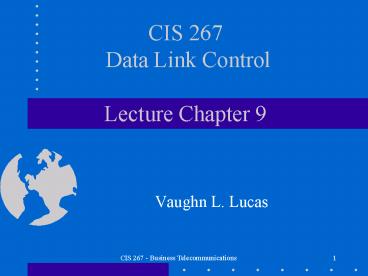CIS 267 Data Link Control Lecture Chapter 9 - PowerPoint PPT Presentation
1 / 22
Title:
CIS 267 Data Link Control Lecture Chapter 9
Description:
3-bit number allows 8 values ... Bit added to each character to make all bits add up to an even ... arranges data into frames, supplemented by control bits ... – PowerPoint PPT presentation
Number of Views:37
Avg rating:3.0/5.0
Title: CIS 267 Data Link Control Lecture Chapter 9
1
CIS 267 Data Link Control Lecture Chapter 9
- Vaughn L. Lucas
2
Chapter 9 Overview
- Topics covered
- Data Link Control Protocol
- A set of techniques that, collectively, is
embodied in a control mechanism - Coordinates the presence of more than two devices
on a line - Provides for error control
- HDLC (high-level data link control)
3
Flow Control
- Necessary when data is being sent faster than it
can be processed by receiver - Computer to printer is typical setting
- Can be from computer to computer when a
processing program is limited in capacity - Usually a buffer is filled, and transfer is
stopped until buffer is emptied
4
Stop-and-Wait Flow Control
- Simplest form of Frame-Oriented Control
- Source may not send new frame until receiver
acknowledges previous one - Very inefficient, especially when a single
message is broken into many small frames - buffer size of receiver is limited
- if error, detected sooner and less data need be
retransmitted
5
Stop-and-Wait Example
- 40 km link, 10 Mbps rate, 1000 bit frame
- Signal in copper propagates at 2 x 108 m/sec
- Takes 0.1 msec to transmit frame
- 0.2 msec delay to begin arriving
- See Figure 9-1
- Total 0.3 msec to receive, 0.2 msec to ACK
- Line busy for 0.5 msec for 0.1 msec frame
- 20 efficiency
6
Sliding-Window Flow Control
- Allows multiple frames to be in transit
- Receiver sends acknowledgement with sequence
number of anticipated frame - Sender maintains list of sequence numbers it can
send, receiver maintains list of sequence numbers
it can receive - ACK (acknowledgement) supplemented with RNR
(receiver not ready)
7
Sliding Window Sequence
- Sequence number included in frame
- 3-bit number allows 8 values
- See Figure 9-2
- http//www.humboldt.edu/aeb3/telecom/SlidingWindo
w.html - Windows not necessarily in synch if many frames
in transit - See Figure 9-3
8
Error Control Process
- All transmission media have potential for
introduction of errors - All data link layer protocols must provide method
for controlling errors - Error control process has two components
- Error detection
- Error correction
9
Error Detection Parity Bits
- Bit added to each character to make all bits add
up to an even number (even parity) or odd number
(odd parity) - Good for detecting single-bit errors only
- High overhead (one extra bit per 7-bit
character12.5)
10
Error Detection CRC
- Cyclic Redundancy Check (CRC)
- Data in frame treated as a single binary number,
divided by a unique prime binary, and remainder
is attached to frame - 17-bit divisor leaves 16-bit remainder, 33-bit
divisor leaves 32-bit remainder - For a CRC of length N, errors undetected are 2-N
- Overhead is low (1-3)
11
Error Correction
- Two types of errors
- Lost frame - never arrives
- Damaged frame - error in bits
- Automatic Repeat reQuest (ARQ)
- Error detection
- Positive acknowledgment if received
- Retransmission after time-out if not ACK
- Negative ACK and retransmission if error
12
Stop-and-Wait ARQ
- One frame received and handled at a time
- If frame is damaged, receiver discards it and
sends no acknowledgment - Sender uses timer to determine whether or not to
retransmit - Sender must keep a copy of transmitted frame
until acknowledgment is received - If acknowledgment is damaged, sender will know it
because of numbering
13
Go-Back-N ARQ
- Uses sliding-window flow control
- When receiver detects error, it sends negative
acknowledgment (REJ) - Sender must begin transmitting again from
rejected frame - Transmitter must keep a copy of all transmitted
frames
14
Data Link Control
- Specified flow and error control for synchronous
communication - Data link module arranges data into frames,
supplemented by control bits - Receiver checks control bits, if data is intact,
it strips them
15
High-Level Data Link Control
- On transmitting side, HDLC receives data from an
application, and delivers it to the receiver on
the other side of the link - On the receiving side, HDLC accepts the data and
delivers it to the higher level application layer - Both modules exchange control information,
encoded into a frame
16
HDLC Frame Structure
- Flag 01111110, at start and end
- Address secondary station (for multidrop
configurations) - Information the data to be transmitted
- Frame check sequence 16- or 32-bit CRC
- Control purpose or function of frame
- Information frames contain user data
- Supervisory frames flow/error control (ACK/ARQ)
- Unnumbered frames variety of control functions
(see p.220)
17
HDLC Frame Structure
18
HDLC Operation
- Initialization S-frames specify mode and
sequence numbers, U-frames acknowledge - Data Transfer I-frames exchange user data,
S-frames acknowledge and provide flow/error
control - Disconnect U-frames initiate and acknowledge
19
Protocols Preview
- OSI Seven-Layer Model
- TCP/IP Layers
- IBMs System Network Architecture
- While OSI model is increasingly out of favor in
application development, it is still very useful
in understanding networking in a conceptual
context
20
ISOs OSIOpen Systems Interconnection
- Application Layer
- Presentation Layer
- Session Layer
- Transport Layer
- Network Layer
- Data Link Layer
- Physical Layer
21
Physical Layer
- Refers to transmission of unstructured bits over
physical medium - Deals with characteristics of and access to the
physical medium
22
Data Link Layer
- Provides for reliable transfer of information
across physical link - Includes
- transmission of blocks of data (frames)
- synchronization
- error control
- flow control































